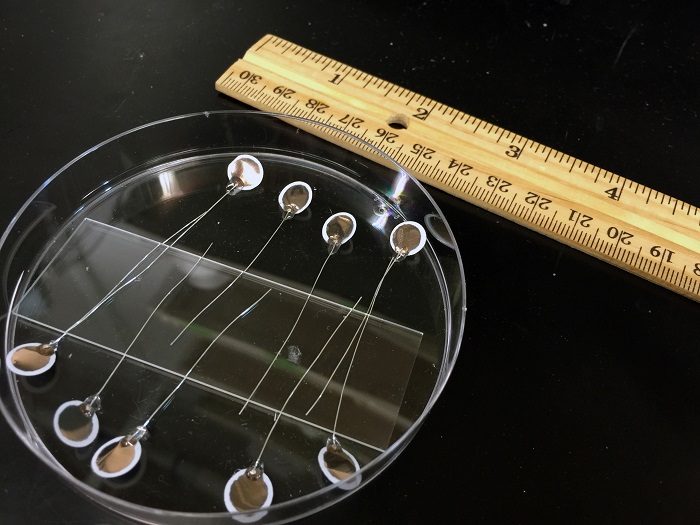Ohio State University engineers have published a paper detailing their use of a thin, plastic membrane in rechargeable batteries to stop discharging when not in use, and to allow for more rapid recharging when the battery is depleted.
It is believed this new design feature can be added to electric vehicle batteries to improve the technology’s overall efficiency.

The plastic membrane controls how charge flows inside the battery; the researchers drew their inspiration for it from how living cell membranes transport proteins in the body. Scaled up, it could see use in high-powered “supercapacitors” for electric cars. It could also serve as a solution to the hoverboard-fire problem that’s afflicted that niche industry of late.

The very best eco-friendly cars today can travel approximately 200 miles after an 8-hour charge; gas-powered cars can cover the same distance after about a minute of time spent at the pump. The researchers believe their technology can boost electric car batteries by tens of miles per minute of charge.
“That's still an order of magnitude away from the equivalent measure in gasoline, but it's a place to start,” said Vishnu-Baba Sundaresan, an assistant professor of mechanical and aerospace engineering at Ohio State and leader of the study. He added that today’s hybrid and electric cars have hit a bit of a performance limit (0.4 miles per minute of charge, across the industry) because of how charge is stored in the vehicle’s battery. Sundaresan believes his team’s solution can help the industry push past the limit, to the point that a new category of battery electrodes are created.
“Research over the last 50-plus years has focused on advancing the chemistry of battery electrodes to increase capacity,” Sundaresan said. “We've done that, but the increase in capacity has come at the cost of robustness and the ability to rapidly charge and discharge batteries. Electric vehicle design is mature enough now that we know the limit they're reaching is because of the chemistry of lithium-ion batteries.”
Sundaresan and his team refer to their solution as “ionic redox transistor”. Presently, they are using it in a new kind of battery wherein energy is stored in a liquid electrolyte. He suggests that users will be able to recharge their vehicle, or otherwise empty it out before refilling it, same as they do today with a gas tank.
“For everyday commuting, the electrolyte can be simply regenerated by plugging it into a power outlet overnight or while parked at the garage. For long road trips, you could empty out the used electrolyte and refill the battery to get the kind of long driving range we are accustomed to with internal combustion engines,” Sundaresan said.
“We believe that this flexibility presents a convincing case for weaning our dependence on internal combustion engines for transportation.”
Lithium-ion batteries today already have membrane separators that conduct charge and serve to physically separate the anode and the cathode from one another; however, even the best designed batteries wind up losing charge over time. This is due to a design flaw with the actual membranes – they’re not able to fully prevent charge from leaking between the anode and cathode. The resulting internal chemical reactions are referred to as “self-discharge”. In best case scenarios, the slow self-discharge converts a portion of the battery’s internal energy into heat, leading to a gradual power drain. Worst case — the leakage causes the batteries to over-heat and catch fire (as is the case with hoverboards). Either scenario is hard to shut down once the process actually begins.
Sundaresan and his team believe their membrane, when used with a specially-designed electronic control unit, can shut down charge transport and in turn, prevent thermal runaway at its onset.
Here’s how it works: the membrane combines an electrically conductive polymer with a polycarbonate filter used for air / water testing. By controlling how the conductive polymer chains are grown on the polycarbonate surface, the team found they could control the density of the resulting openings in the actual membrane.
More simply, when the battery is charging / discharging, the conductive polymer will shrink, thereby opening the holes; when the battery’s not in use, the polymer will swell up so that the holes shrink and close over.
While experimenting with the membrane, the team found that it reliably controlled charging / discharging in batteries powered by ions of lithium, sodium, and potassium. Hooked up to an LED light, these batteries each proved capable of functioning normally, and reducing charge loss to zero when not in use.
Looking ahead, the team hopes to develop a new “redox flow battery”, in which an electrolyte is pumped from the anode to the cathode to generate power, via their membrane.
To learn more, read the team’s paper Ionic redox transistor from pore-spanning PPy membranes, which was published in the journal, Energy and Environmental Science.
Advertisement
Learn more about Electronic Products Magazine





